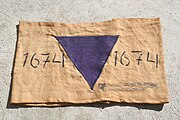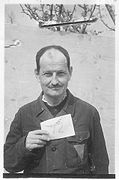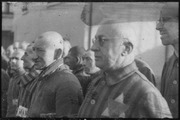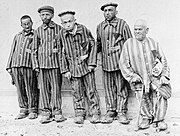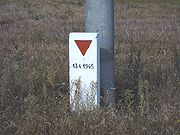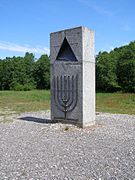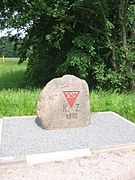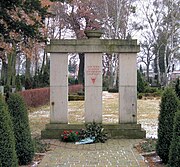Nazi concentration camp badge

Nazi concentration camp badges, primarily triangles, were part of the system of identification in Nazi camps. They were used in the concentration camps in the Nazi-occupied countries to identify the reason the prisoners had been placed there.[1] The triangles were made of fabric and were sewn on jackets and trousers of the prisoners. These mandatory badges of shame had specific meanings indicated by their colour and shape. Such emblems helped guards assign tasks to the detainees: for example, a guard at a glance could see if someone were a convicted criminal (green patch) and thus likely of a "tough" temperament suitable for kapo duty. Someone with an "escape suspect" mark usually would not be assigned to work squads operating outside the camp fence. Someone wearing an F could be called upon to help translate guards' spoken instructions to a trainload of new arrivals from France. Some historical monuments quote the badge-imagery; the use of a triangle being a sort of visual shorthand to symbolize all camp victims. Also, the modern day use of a pink triangle emblem to symbolize gay rights is a response to the camp identification patches.
Badge coding system
The system of badges varied between the camps, and in the later stages of World War II, the use of badges dwindled in some camps, and became increasingly accidental in others. The following description is based on the badge coding system used before and during the early stages of the war in the Dachau concentration camp, which had one of the more elaborate coding systems.
Shape was chosen by analogy with the common triangular road hazard signs in Germany that denote warnings to motorists. Here, a triangle is called inverted because its base is up while one of its angles points down.
Single triangles
- Red triangle—political prisoners: liberals, communists, trade unionists, social democrats, socialists, Freemasons, and anarchists.
- Green triangle— "professional criminals" (convicts, often working in the camps as Kapos).
- Blue triangle—foreign forced laborers, emigrants.
- Purple triangle—Bible Students, a term taken from a name of, and primarily referring to, Jehovah's Witnesses, though a very small number of pacifists and members of other religious organizations were also imprisoned under this classification
- Pink triangle—sexual offenders, mostly homosexual men but rarely rapists, zoophiles and paedophiles.[2]
- Black triangle—people who were deemed "asocial elements" and "work shy" including
- Roma (Gypsies), who were later assigned a brown triangle
- The mentally ill
- Alcoholics
- Vagrants and beggars
- Pacifists
- Conscription resisters
- Prostitutes[3][4][dead link]
- Some anarchists
- Drug addicts
- Brown triangle—Roma (Gypsies) (previously wore the black triangle).[5]
- Uninverted red triangle—an enemy POW, spy or a deserter.
People who wore the green and pink triangles were convicted in criminal courts and may have been transferred to the criminal prison systems after the camps were liberated.
- Some period examples of the single triangle design at Nazi camps
-
Single-triangle badges in various colors visible on Sachsenhausen concentration camp detainees.
-
Single-triangles visible on Sachsenhausen detainees.
-
Specimen indicating a Jehovah's Witnesses.
-
More Sachsenhausen detainees.
-
Triangles visible on trousers of Dachau detainees.
-
U.S. Army photo of Buchenwald survivor Benedikt Kautsky.
-
Liberated Neuengamme survivor standing on the right has a triangle patch with a top-bar.
Double triangles
Double-triangle badges resembled two superimposed triangles forming a Star of David, a Jewish symbol.
- Two superimposed yellow triangles, the "Yellow badge"—a Jew
- Red inverted triangle superimposed upon a yellow one—a Jewish political prisoner
- Green inverted triangle upon a yellow one—a Jewish "habitual criminal"
- Purple inverted triangle superimposed upon a yellow one—a Jehovah's Witness of Jewish descent[6]
- Pink inverted triangle superimposed upon a yellow one—a Jewish "sexual offender"
- Black inverted triangle superimposed upon a yellow one—"asocial" and "work shy" Jews
- Voided black inverted triangle superimposed over a yellow triangle—a Jew convicted of miscegenation and labelled as a "race defiler"
- Yellow inverted triangle superimposed over a black triangle—an Aryan (woman) convicted of miscegenation and labelled as a "race defiler"
Like those who wore pink and green triangles, people in the bottom two categories would have been convicted in criminal courts.
- Some period examples of the double triangle design at Nazi camps
-
Sachsenhausen detainee with glasses in the foreground wears a two-color ID-emblem.
-
Disabled Jews with a black triangle on a yellow triangle, meaning "asocial Jews". Buchenwald, 1938.
-
Part of a Dachau roll call --badges visible on detainees.
-
Sachsenhausen detainee's red "political enemy" triangle and yellow Jew triangle. ^
Other badges
In addition to colour-coding, some groups had to put letter insignia on their triangles to denote country of origin. Red triangle with a letter, for example: "B" (Belgier, Belgians), "F" (Franzosen, French), "H" (Holländer, Dutch), "I" (Italiener, Italians), "J"[7] (Jugoslawen, Yugoslavs), "N" (Norweger, Norwegian), "P" (Polen, Poles), "S" (Republikanische Spanier, Republican Spanish) "T" (Tschechen, Czechs), "U" (Ungarn, Hungarians).[citation needed]
Also, repeated offenders would receive bars over their stars or triangles, a different colour for a different crime.
- A political prisoner would have a red bar over his/her star or triangle
- A professional criminal would have a green bar
- A foreign forced laborer would have a blue bar
- A Jehovah's Witness would have a purple bar
- A homosexual or sex offender would have a pink bar
- An "asocial" would have a black bar
- A Roma (Gypsy) would have a brown bar
Many various markings and combinations existed. A prisoner would usually have at least two, and possibly more than six.
Some camps assigned Nacht und Nebel prisoners with two large letters, NN, in yellow.
Penal battalion, penal company, etc., are military units consisting of convicted persons for which military service was either the assigned punishment or a voluntary replacement of imprisonment.
Detainees wearing civilian clothing (more common later in the war) instead of the striped uniforms were often marked with a prominent X on the back.[8] This made for an ersatz prisoner uniform. For permanence, such Xs were made with white oil paint, with sewn-on cloth strips, or were cut (with underlying jacket-liner fabric providing the contrasting color). Detainees would be compelled to sew their number and (if applicable) a triangle emblem onto the fronts of such X-ed clothing.[9]
- Some period examples of nationality-letter marking at Nazi camps
-
F on red triangle (French political enemy) on Buchenwald clothing of Dr Joseph Brau. ^
-
F-triangle on Buchenwald clothing of Dr Joseph Brau. ^
-
Specimen meaning Polish political enemy.
-
Stutthof detainee 29659 – Lidia Główczewska: P on a red triangle for Polish political enemy.
-
Auschwitz detainee Ignacy Kwarta wears a red P-triangle: a Polish political enemy.
-
Dutch Jews wearing a yellow star and the letter N for Niederländer at Buchenwald.
-
Sachsenhausen-issued red F emblem for a French political enemy. ^
-
Emblems were also used on some detainee ID-cards --here, on the Mauthausen card of Polish scientist Jerzy Kaźmirkiewicz, a P-triangle appears. ^
-
Dachau survivors toast their liberation. The man standing in center between the bottles wears a P triangle.
-
Liberated Bergen-Belsen survivor with (left) a late war ersatz variant: no cloth patch, but a prominent N marked on the outer clothes.
Table of camp inmate markings
| Special markings |  Jewish race defiler |
 Female race defiler |
 Escape suspect |
Inmate number  Special inmates' brown armband |
 Applicable marks were worn in descending order as follows: inmate number, repeater bar, triangle or star, member of penal battalion, escape suspect. In this case, the inmate is a Jewish convict with multiple convictions, serving in a penal battalion, Strafkompanie. | ||
 Pole: "P" on a red triangle |
 Czech: "T" (the German word for Czech is Tscheche) on a red triangle |
 Member of the armed forces: red triangle, an enemy POW or a deserter. | |||||
Postwar use
Triangle-motifs appear on many postwar memorials to the victims of the Nazis. Most triangles are plain while some others bear nationality-letters. The otherwise potentially-puzzling designs are a direct reference to the identification patches used in the camps. On such monuments, typically an inverted (point down, base up) triangle (especially if red) evokes all victims, including also the non-Jewish victims like Slavs, Poles, communists, gays, Roma (see Porajmos), the handicapped (see Action T4), and Soviet POWs. An inverted triangle colored pink would symbolize gay male victims. A non-inverted (base down, point up) triangle and/or a yellow triangle is generally more evocative of the Jewish victims.
- Some examples of camp triangle emblems on monuments and related uses
-
At Sachsenhausen.
-
A Dora Todesmarsch (death march) roadside tablet marked only with the date and a red triangle.
-
On the Klooga Jewish victims' memorial.
-
On a Buchenwald Todesmarsch (death march) route historical marker.
-
On a Sachsenhausen death march route historical marker.
-
Monument (in the village of Grabow-Below) for Ravensbrück death march victims.
-
On a Wöbbelin memorial stone.
-
Boulder (in Lindenring) "for 2000 women" victims of Ravensbrück.
-
At the Neustadt-Glewe concentration camp memorial.
-
F-triangle at Mauthausen-Gusen honors French victims.
-
F-triangle at Hinzert honors French victims --especially of the Nacht und Nebel (Night and Fog) program.
-
On a Langenstein-Zwieberge memorial (pictured on an East German stamp).
-
On a monument to Neuengamme victims in Hamburg. The letters KZ are not nationality-letters but rather are the German abbreviation for Konzentrationslager (concentration camp).
-
On a memorial to victims killed at Genshagen (right panel). The letters KZ are not nationality-letters but rather are the German abbreviation for Konzentrationslager (concentration camp).
-
P-triangle at a Zgorzelec memorial.
-
P-triangle on the Polish medal for camp victims.
-
On a Cap Arconia incident memorial.
-
In the Berlin Nollendorfplatz subway station, a pink triangle plaque honors gay male victims. (Photo by: Manfred Brueckels.)
-
Amsterdam's recently-built Homomonument uses pink triangles symbolically to memorialize gay men killed in the Holocaust (and also victims of anti-gay violence generally).
Notes
- ^ Nazis Open Dachau Concentration Camp
- ^ Plant, The Pink Triangle.
- ^ Claudia Schoppmann: Nationalsozialistische Sexualpolitik und weibliche Homosexualität (Dissertation, FU Berlin, 1990.) Centaurus, Pfaffenweiler 1991 (revisited 2nd edition 1997). ISBN 3-89085-538-5
- ^ "Black triangle women". 2001-02-01. Retrieved 2008-02-02.
- ^ Jewish Virtual Museum: Badges
- ^ Note that since "Jew" was defined along "racial" lines, such as by the Nuremberg Laws, Jews could be classified as Jehovah's Witnesses.
- ^ Politika: У Аушвицу, на вест о ослобођењу Београда
- ^ Rochelle G. Saidel (2006). "The Jewish Women of Ravensbruck Concentration Camp (pg 76)". Retrieved May 20, 2013.
- ^ Rochelle G. Saidel (2006). "The Jewish Women of Ravensbruck Concentration Camp (pg 76)". Retrieved May 20, 2013.
References
- Plant, Richard, The Pink Triangle: The Nazi War Against Homosexuals, Owl Books, 1988, ISBN 0-8050-0600-1.
- Camp badge chart at historyplace.com
- Additional camp badge chart
External links
- United States Holocaust Memorial Museum Classification system in Nazi concentration camps.
- Stars, triangles and markings – Jewish Virtual Library
- Gay Prisoners in Concentration Camps as Compared with Jehovah's Witnesses and Political Prisoners by Ruediger Lautmann



